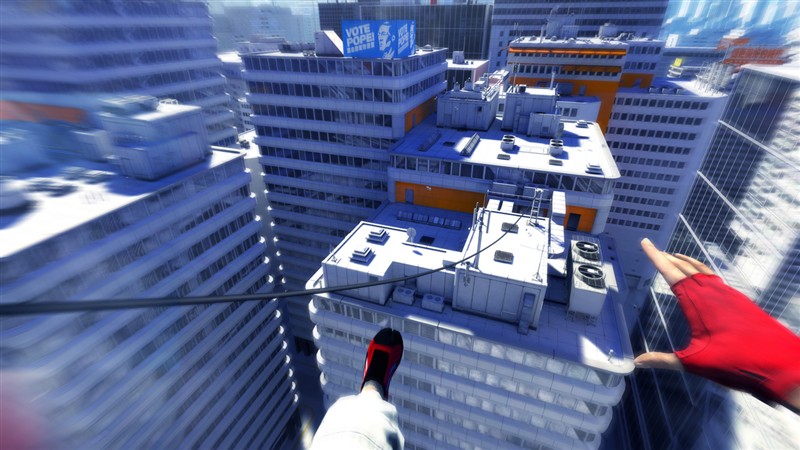When the first images of Mirror’s Edge were presented to us, I was intrigued by the art direction and very interested in the game’s premise. You are Faith, a runner in a modern, yet futuristic city where an oppressive regime monitors all electronic activity. To send mail securely the runners are employed by companies to deliver documents by hand, and to do this the city becomes a playground of opportunity. Using the phenomenon that is Parkour or free running, the runners are able to navigate the city away from prying eyes by jumping from the rooftops and such like, making their own pathways. There’s a very ninja like quality to the runners, but are based more on realism than super abilities. That’s not to say Mirror’s Edge is totally realistic as it does take some liberties. Using a first person viewpoint, as tenacious Faith, your job is to find out why your sister has been framed for murder. However, things aren’t easy as the authorities are hot on your heels from the offset because Faith has been spotted leaving the crime scene.
Gameplay:
Mirror’s Edge begins with a training ground to get you familiar with the general workings of the moves. There’s no third person view of Faith, and so you’ll need to get in tune with how jumping, running, vaulting etc can be performed using the first person viewpoint. It’s a interesting design feature for this type of game, and certainly puts you into the character more than seeing Faith’s rear for entirety. There are very few actual moves on offer here, thus making the game very easy to get into. LB jumps, LT crouches, RB performs a quick turn, Y disarms opponents when close, and finally RT is used for attacking with fists. You can combine these to perform more advanced moves, but in reality for beginners you’ll get by easily using the basics.
The game’s prologue level pretty much sums up the basic experiences you’ll get from the rest of the game, although in some respects is somewhat misleading, because in the later levels you’ll be spending some time trying to figure out where to go. It’s not all rooftop jumping and chase sequences as you’ll discover lots of interior sections and some ground level antics as well. There’s also a strong puzzle element in a similar vein to the Tomb Raider games, which means you’ll be looking around wondering where to go next on occasion. Luckily there is a handy option to press the B button at any time to point you in the general direction, although in many cases this can be rather vague. The puzzles are all well suited to free running as it’s quite challenging working out how you’re going to navigate certain areas.
The free-running aspect of the game is the main draw here, and due to the first person view makes it more engaging. The levels offer a pretty straight forward path to your objective, yet at the same time it’s up to the player to decide how they get there. The game does offer some handy hints in the form of runners vision, which basically highlights objects and things to grab, jump or smash in red. So you’re never really too far from a hint of sorts. For purists and those tackling the Hard difficulty, you can actually switch off this feature for a more natural experience. I think it’s only when you become familiar with a level and replay it, that you begin to see other opportunities arise. There’s a tendency to follow the scripted path (which you have to in many cases) but on closer inspection and once you’ve improved your skills, you will start notcing other routes which you missed the first time. It’s actually quite rewarding making new discoveries, as long as you take the time to look around. This is sometimes not possible as you are often being chased by numerous guards shooting at you, or helicopters tracking you down and also shooting at you. Therefore a little experimentation is required if you want to do things differently. Luckily, you’re able to replay completed levels at any time.
Death in Mirror’s Edge is frequent, and like the Tomb Raider games, and more-so in line with the leading character’s name, you will have to make many leaps of faith, often to your demise. The combat elements are also very fast paced which means a few bullets in your direction and Faith is dead. Luckily if you’re quick enough or find somewhere to momentarily hide, Faith’s health recharges. The game does have a pretty solid checkpoint system, so you’re never required to restart that far from where you died. I think it’s easy to assume (especially from the opening level) that you’ll be able to just breeze through the game like a pro, well this is not the case so be prepared to learn from your mistakes.
Mirror’s Edge features an interesting take on combat, because most of us are familiar with shooting using a first person viewpoint. However, shooting is a part of Mirror’s Edge but you’re basically encouraged not to use guns, and in fact avoid confrontations entirely. The disarm move is quite neat, but a little tricky to pull off fluidly, and so you’re able to utilize some hand to hand combat instead if you choose. This comes in the form of fists and feet in a very simplistic manner, although again you’re encouraged to avoid rather than engage. It’s clear to see that DICE wanted to give the player options to tackle situations their own way, although in my experience running is probably the best method because this is what Faith is good at. When she wields a weapon, her moves become sluggish and she basically loses her runner abilities until you ditch the weapon, especially the heaver machine guns. The hand to hand is quite satisfying when you get it right, but can get a little confusing when faced with multiple foes. The AI is actually quite clever at times and won’t necessarily rush you all the time. They work well in groups and try and close you down effectively.
Graphics:
I was very impressed with the rather squeaky clean looking images for the game pre-release, and now that I can see the game in the flesh so to speak, DICE have done a rather splendid job of rendering the city and interior locations. At times there’s an almost photo realistic sheen especially when inside the buildings. There’s an over abundance of simple bold colours used to great effect throughout the game, making for familiar yet fantastical areas. There’s also a lot of over saturated lighting which again, adds a distinctive style to the game. In some cases there’s a very simplistic layer to the graphics, as objects can be quite angular as you’d expect, and the use of flat surfaces with no blemishes really does make things stand out. I read a comment likening the game’s interiors to an Ikea catalog and I can fully appreciate this sentiment, because everything is so remarkably clean/neat looking. The game has a very bold art style which I’ve not seen used to such great effect before. In motion the game offers some neat effects to support the free flowing actions of running. The camera work is exceptional, and moves perfectly with what Faith is doing, whether that be running at full pelt with a slight sway or mantling objects. There are some noticeable lack of details in some places, but the reality is that you’re supposed to be focusing on the gameplay rather than marveling (or not) at some minor details – such as the water looking rather horrid in the opening level.
Between each level, Mirror’s Edge uses the same anime style cutscenes which were used for some of the pre-release media. I’m in two minds about these, because on one hand the animation is very good, but on the other they are somewhat distracting from the actual game considering the differences between the two. I personally would have preferred the game engine to be used, but alas the anime is suffice.
Playing the game is ultra smooth as the Xbox 360 version is slick, precise, and fluid all the way through. Discrepancies like slowdown, screen tearing and other oddities make no appearances here, although to be honest there generally isn’t too much going on at any particular moment to warrant an appearance by these issues.
Audio:
There’s an unprecedented use of audio in Mirror’s Edge, and it’s quite obvious that a lot of time was invested in getting not only the soundtrack to be spot on for the type of game it is, but also the sound effects. The music is breathtaking at times offering ambient sounds fused with some more upbeat dance tracks for the more intense moments. These are just so perfectly placed that I can honestly say that whether you like the style or not, you’re going to have to agree. There’s a lot of airy sustained chords which compliment the exploratory elements, offering ambiance of mystery and intrigue. The more heady tunes really drive you along, adding intensity to running, jumping and escape.
The sound effects are well realised and as you’d expect there’s the constant rhythm of footsteps, accompanied by heavy landings and impacts with surfaces. You never forget who you are, especially as you never see Faith fully, bar a brief moment or two at the beginning and end of the game. You’ll hear the sound of heavy breathing, gasps of exertion when climbing and pressure when landing, alongside the usual sounds of being hit by bullets or suffering a hard landing. It’s all captured very well and puts you into the character. There have been many games that ignore these features but I find that there is very good attention to detail here.
The voice acting in general during the cutscenes and radio chatter as you play is quite good, Faith is strong, hard edged and determined, although she does come across like a tom boy. As a character, Faith is attractive, although I think the game removes the sexuality of the female lead, and does so in a way that you appreciate her for the abilities she has. There’s some reasonable lines of dialogue, and a story that is easy follow which ties everything neatly together. It’s certainly not overly complex for complexities sake and should be appreciated by most age groups.
Longevity:
Mirror’s Edge offers several modes of play, and if you start at the story mode you’ll probably clock in around five or six hours on your first play. For some this might seem a little short, but you can put that down to the game being engaging enough that you are simply left wanting more after its conclusion. However, I’m a firm believer in the game warranting multiple plays. For starters, once you beat the game you unlock a speed run mode, which offers the same story but with a timer and time to best. This is very tough, and requires that you learn how to navigate the levels as quickly as possible. It’s also here that finding new routes and ways to do things is paramount to success. You can replay the levels you’ve completed which helps in making these new discoveries. There are also leaderboards which you can see how well you are doing on a global level.
Mirror’s edge also offers an additional Hard difficulty for when you’ve beaten the game, this ups the AI intensity and removes the runner vision by default. This mode is clearly the real mode, and the way I visualize it, is you play normal or easy, to get familiar with the environments/moves, so yes, there will be a very stop / start, trial and error flavour here. Then once you’ve nailed it, you can attempt the hard mode with a more fluid approach. It here where the game really shines and picks up pace as you reach your objectives in the most flawless of ways.
There is also a time trial mode, which offers checkpoints for you to navigate to in the quickest time possible. Again, you can download ghosts via Live or race your own to see if you can shave seconds off your time. These also have related leaderboards to see how you fare against friends and others.
When you combine the story which really does have to be played more than once to be fully appreciated, and the additional modes you have, Mirror’s Edge does offer plenty of replay value. However if you’re not the exploring type, then to be honest this really is not your kind of game and you may feel somewhat unfulfilled once you’ve beaten it. There are some decent achievements as well on offer, and if you’re looking for gaining them all, then expect that six hours to increase dramatically, because there’s suitable challenge here.
Overall:
Mirror’s Edge has been a joy to play and I’ve fully appreciated what DICE have tried to achieve here, although not everyone will. It’s hard to actually find fault with the game, although it’s very clear to see that there’s certainly areas which could be improved. Level editors for those of you who want to get into the Parkour spirit would be a neat addition, as would having full replays which you could share online. Then there’s the multiplayer aspect which is touched upon with the ghosts, but is obviously not the same as having three or more other players in the game – perhaps even a co-op mode where you share moves in a similar manner to Splinter Cell Chaos Theory’s multiplayer. Also a more refined combat system could be used for future games, offering more dynamic attack moves.
That said, Mirror Edge is a valiant first effort for a new intellectual property, and DICE have the foundations here for an excellent series. Based on its own merits and what’s included rather than what isn’t, Mirror’s Edge is a great game, although I can appreciate that not every gamer is going to “get” the philosophy behind it. There is a level of patience required as you learn, and for those of you weaned on full on action games, the pacing might prove a little frustrating at first. It’s part racing, part chasing, exploration, and offers some shooting, hand to hand to spice things up. There’s many games I would say have similar elements, Splinter Cell, Tomb Raider and Jet Set Radio being some of them. Mirror’s Edge offers it’s own take on these games (not necessarily a deliberate design process) and presents a title that really should be played for the experience. It’s classy, it looks good and has a very solid feel to it. The game is also quite easy in some respects which should open it up to a wider audience. I would highly recommend this game whether you rent or buy, but to truly get the most from it, you’ll have to have an open mind for exploration and improving your skills. This is certainly well worth asking Santa to leave a copy under your Christmas tree this year.
8.5/10




